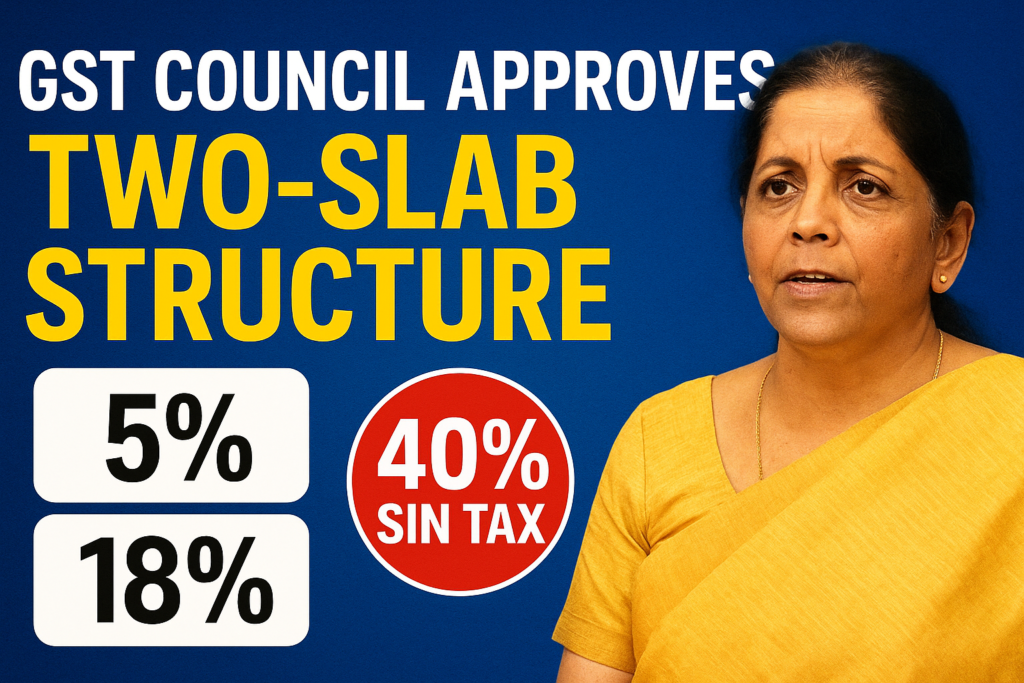India’s GST Council revamps tax slabs to 5% & 18% with a 40% sin tax. Find out what items are cheaper, what’s costlier, and how it impacts your wallet.
GST 2.0 Unleashed: A Diwali Gift for the Common Citizen

In a spirited 10.5-hour meeting on September 3, 2025, the GST Council, under the leadership of Finance Minister Nirmala Sitharaman, moved decisively to overhaul India’s tax landscape. The outcome? A sleek two-slab system—5% and 18%—enriched by a 40% “sin good” rate for select indulgences. This reform, poised to take effect on September 22, 2025, the dawn of Navratri, marks a tectonic shift in tax policy.
Prime Minister Modi praised the action as a push for ease of living, benefiting MSMEs, the middle class, farmers, and women—an inclusive message emanating from the heart of the Red Fort.
A Sharp Trim for Everyday Essentials
1. Grocery & Household Staples Made Lighter
Zero-rated essentials: UHT milk, paneer, all Indian breads (roti, chapati, paratha), pizza bread, khakra, erasers and other education tools: nil GST.
Items like butter, ghee, cheese, dairy spreads, namkeens, bhujia, sauces, and beverages now enjoy the 5% slab—a significant drop from 12–18%.
Everyday personal care: hair oil, shampoo, toothpaste, soap bars, shaving cream—now just 5% GST.
2. Health, Insurance & Education Get Big Relief
Life and health insurance for individuals, including senior citizens and family floaters: completely tax-free.
Medical necessities—thermometers, diagnostic kits, oxygen, spectacles—moved to 5%.
School supplies—pencils, crayons, exercise books, globes, maps—zero GST.
3. Farming & Housing Inputs: A Helping Hand
Farmers rejoice: tractor tyres, parts, tractors, farm machinery—5% GST, down from 12–18%.
4. Appliances, Autos & Infrastructure Demand Come Alive
White goods—ACs, TVs (>32″), dishwashers, projectors—now taxed at 18%, reduced from 28%.
Cement and auto components: 18% GST, significantly lower than before.
Smaller vehicles: 18% GST applies to cars ≤1200 cc (petrol), ≤1500 cc (diesel), bikes ≤350 cc, three-wheelers—down from 28%.
EVs remain fiscally sweet at 5% GST.
A Bite from the “Sin Tax”: Luxury & Harmful Goods
Not everything gets cheaper. The GST Council has imposed a sharp 40% GST on items deemed indulgent or socially harmful:
Sin goods: pan masala, gutkha, cigarettes, chewing tobacco, bidis—jumping from 28%.
Sugary & carbonated drinks, energy drinks, caffeinated beverages—now taxed heavily at 40%.
Luxury transportation includes large cars (>1200 cc petrol, >1500 cc diesel, >4 m length), yachts, and personal aircraft—40% GST.
Despite the rate increase, experts believe prices will not rise—manufacturers may absorb costs, and input revisions may mitigate the impact.
Economic Ripples: From Markets to Everyday Wallets
Markets React with Gusto
Indian equities markets jumped in early trading, with the Nifty up 1.08% and the Sensex up 1.1%, fueled by optimism about festive demand and market-friendly policies.
The auto and consumer sectors led advances as investors factored in the expected Christmas boost.
Inflation & Revenue: A Delicate Balance
Revenue loss estimate: ₹48,000 crore—significant, but lower than earlier projections.
Inflation: potentially trimmed by 1.1 percentage points, especially if benefits pass fully to consumers.
Final Thoughts: A Bold, Human-Centric Reform
This is more than just a tax change; it’s a structural shift. A deliberate endeavor to reduce the burden on families, strengthen businesses, and push the economy forward, all while discouraging unhealthy consumption.
From paneer to policy, cement to vehicles, Diwali 2025 brings a GST regime designed to simplify, comfort, and stimulate.
